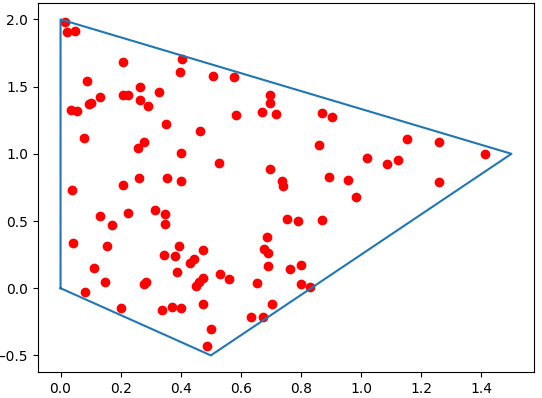Generate Random Points in a Polygon
We present two alternatives to generate random points within a polygon in python: a very simple (but slow) method, and a faster one that relies on Geopandas spatial joins.

Slow method: generate and filter points one by one
As a first attempt, we might be tempted to use Shapely to filter the points one by one.
The problem with this approach is that it is extremely inefficient, but for few dozens of points, this is perhaps acceptable.
The slow algorithm looks like this:
import numpy as np
from shapely.geometry import Point
def Random_Points_in_Polygon(polygon, number):
points = []
minx, miny, maxx, maxy = polygon.bounds
while len(points) < number:
pnt = Point(np.random.uniform(minx, maxx), np.random.uniform(miny, maxy))
if polygon.contains(pnt):
points.append(pnt)
return pointsLet’s test this with a simple polygon
polygon = Polygon([[0,0],[0,2],[1.5,1],[0.5,-0.5],[0,0]])
points = Random_Points_in_Polygon(polygon, 100)
# Plot the polygon
xp,yp = polygon.exterior.xy
plt.plot(xp,yp)
# Plot the list of points
xs = [point.x for point in points]
ys = [point.y for point in points]
plt.scatter(xs, ys,color="red")
plt.show()
However, as soon as you want to generate thousands of points, the performance impact will be substantial, and this is where a faster algorithm becomes necessary.
Fast method with Numpy and Geopandas
As a first step, we’ll generate a number of random points in the bounding rectangle of a given polygon:
import numpy as np
from shapely.geometry import Point, Polygon
def Random_Points_in_Bounds(polygon, number):
minx, miny, maxx, maxy = polygon.bounds
x = np.random.uniform( minx, maxx, number )
y = np.random.uniform( miny, maxy, number )
return x, yAs a second step, we can use a fast point-in-polygon method provided by Geopandas, and discussed in this post, relying on a technique which goes by the name of spatial join.
Let’s first create a GeoDataFrame with our Shapely polygon
import geopandas as gpd
polygon = Polygon([[0,0],[0,2],[1.5,1],[0.5,-0.5],[0,0]])
gdf_poly = gpd.GeoDataFrame(index=["myPoly"], geometry=[polygon])Now, let’s create another GeoDataFrame with random points in the bounding box of our polygon.
import pandas as pd
x,y = Random_Points_in_Bounds(polygon, 10_000)
df = pd.DataFrame()
df['points'] = list(zip(x,y))
df['points'] = df['points'].apply(Point)
gdf_points = gpd.GeoDataFrame(df, geometry='points')And finally, we compute the spatial join to match points and polygons
Sjoin = gpd.tools.sjoin(gdf_points, gdf_poly, predicate="within", how='left')
# Keep points in "myPoly"
pnts_in_poly = gdf_points[Sjoin.index_right=='myPoly']
# Plot result
import matplotlib.pyplot as plt
base = gdf_poly.boundary.plot(linewidth=1, edgecolor="black")
pnts_in_poly.plot(ax=base, linewidth=1, color="red", markersize=8)
plt.show()
Conclusion
If performance is not important, generating points one by one and filtering them with polygon.contains() can do the job.
However, when generating thousands of random points in polygons, performance could become an issue. In that case, using Geopandas spatial joins is a possible solution.
There are alternative methods, of course, like triangulating the polygon and generating random points in each triangle, in proportion with their corresponding areas.
